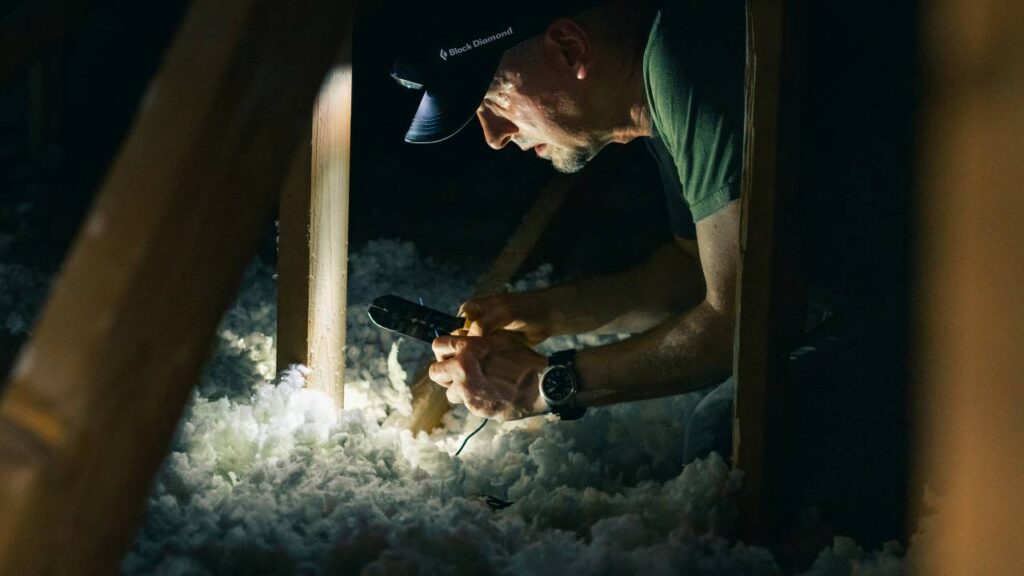Choosing the right insulation for your home doesn’t have to break the bank. With a range of cost-effective options available, you can make your house more energy-efficient without spending a fortune. The most affordable options include fibreglass batts, cellulose insulation, and spray foam, each offering unique benefits for various home types and needs.
Fibreglass batts are easy to install and widely available, making them a popular choice for many homeowners. If you’re looking for an environmentally friendly option, cellulose insulation, made from recycled paper, might be your ideal pick.
Spray foam offers excellent energy efficiency and air sealing but tends to be pricier upfront. Balancing your budget with the needs of your home is key, and this guide will help you make an informed decision.
Understanding Insulation Basics
Home insulation is crucial for maintaining energy efficiency and reducing heat loss in your house. By improving insulation, you can gain a better Building Energy Rating (BER) and lower your energy bills.
The Role of Insulation in Energy Efficiency
Insulation plays a vital role in minimising heat loss by creating a barrier that traps heat inside your home. Good insulation prevents warm air from escaping during winter and keeps the interior cool during summer.
Properly insulated homes require less energy for heating and cooling, resulting in lower energy costs. Your BER will also improve, which is important for property value and energy performance.
Measuring Insulation Effectiveness: The R-Value
The effectiveness of insulation is measured by its R-Value, which indicates its thermal resistance. Higher R-Values mean better insulation performance.
Different materials have varying R-Values, and the ideal value depends on your local climate and the area of your home being insulated. Always choose materials with appropriate R-Values to ensure optimal energy efficiency and comfort.
Types of Insulation Materials
When insulating your home, it’s essential to consider various materials for energy efficiency and cost-effectiveness. These materials include fibreglass, mineral wool, polystyrene beads, rigid foam boards, cellulose, and wool.
Fibreglass and Mineral Wool
Fibreglass is one of the most common insulation materials. Made from fine strands of glass, it’s available in rolls or batts. Advantages include its affordability and effectiveness in reducing heat loss. It’s also non-combustible, enhancing fire safety.
Mineral Wool, including rock wool and slag wool, provides excellent thermal and acoustic insulation. It’s fire-resistant and does not absorb water, making it suitable for humid conditions.
Drawbacks: Both materials can cause skin irritation, so wearing protective gear during installation is advisable. Installation can be messy and may require professional help.
Polystyrene Beads and Rigid Foam Boards
Polystyrene Beads work well in cavity walls. They fill spaces effectively, providing good thermal insulation. They’re lightweight and easy to install, often poured into cavities with specialised equipment.
Rigid Foam Boards like expanded polystyrene (EPS) and extruded polystyrene (XPS) are also popular. These boards offer high insulation value and are suitable for walls, roofs, and floors. EPS is more cost-effective, while XPS has better moisture resistance.
Limitations: These materials can be more expensive than traditional options and may require careful installation to avoid gaps that could reduce efficiency.
Natural Insulation Options: Cellulose and Wool
Cellulose insulation, made from recycled paper products, is an eco-friendly option. It offers good thermal and sound insulation properties. It’s often treated with fire retardants for added safety and can be blown into walls and attics.
Wool insulation, particularly sheep’s wool, is another natural choice. It provides excellent thermal properties and regulates humidity by absorbing and releasing water vapour without losing its insulating capability.
Considerations – natural insulation materials can be pricier but offer sustainable advantages. They’re also biodegradable and often have lower energy costs associated with production.
Critical Areas for Home Insulation
Proper home insulation involves addressing key areas to enhance thermal efficiency and reduce energy costs. Focus on insulating the attic, walls, floors, and pipes for a cost-effective and comfortable home.
Attic Insulation Essentials
The attic is one of the most critical areas in your home for insulation. Heat rises and can escape through an uninsulated attic, leading to higher energy bills. You can use materials like fibreglass, mineral wool, or spray foam for effective attic insulation.
Consider the thickness of the insulation and ensure it meets the recommended standards for Ireland. Properly sealed attic hatches and covering any gaps around pipes and vents can significantly improve insulation effectiveness.
Wall Insulation: Cavity and Solid
Walls are another crucial area for insulation, with two primary types: cavity wall insulation and solid wall insulation.
Cavity wall insulation involves filling the space between the walls with insulating material like EPS beads or fibreglass. It’s cost-effective and reduces heat loss.
Solid wall insulation, either internal or external, provides better thermal performance. Materials like insulation boards or render systems are used. It may require more investment but offers substantial energy savings.
Floor Insulation for Thermal Comfort
Insulating floors can prevent heat loss and improve thermal comfort in your home. Both concrete and timber floors benefit from different insulation methods.
For concrete floors, rigid foam insulation boards are effective. Ensure to cover the entire floor surface. For timber floors, mineral wool or rigid foam can be installed between the joists. Insulating underfloor heating systems can further enhance efficiency.
Insulating Pipes and Other Areas
Insulating pipes reduces heat loss and prevents freezing during cold months. Use foam pipe insulation or lagging to cover exposed pipes, especially those in unheated areas like attics and garages.
Check other areas such as windows, doors, and basements for potential insulation needs. Sealing gaps and using draught excluders can improve overall thermal efficiency and comfort in your home.
Cost-Effective Insulation Solutions for Homes
Insulating your home effectively can significantly reduce energy bills and increase warmth and comfort. Below are the key points on achieving warmth and comfort on a budget and comparing different types of home insulation by cost.
Achieving Warmth and Comfort on a Budget
When looking to insulate your home on a budget, consider the material costs and the installation process. Simple solutions like loft insulation are often cost-effective and easy to install. You can use fibreglass rolls, which are inexpensive and widely available.
For walls, cavity wall insulation with polystyrene beads can offer good protection from the cold and are relatively affordable. Investing in double-glazed windows can also help maintain a warm environment, though they might be a bit pricier initially.
Lastly, don’t overlook floor insulation. Materials like rigid foam can be placed beneath floorboards, which helps keep the lower part of your home warmer and cuts down on energy bills.
Comparing Insulation Types by Cost
When comparing the costs of various insulation types, fibreglass tends to be the most budget-friendly. For around €5-€7 per square metre, it’s a good starting point. Polystyrene beads used in cavity walls cost approximately €10-€12 per square metre.
Spray foam insulation is slightly more expensive, ranging from €15-€20 per square metre but offers excellent sealing properties. For those considering double-glazing, prices can vary widely, from €400-€600 per window. Though initially higher, the long-term savings on energy bills can be significant.
Compare these costs relative to the energy savings they provide to ensure you get the best value for your money. Opting for a mix of these materials tailored to different areas of your home can maximise both insulation quality and cost-effectiveness.
Grants and Financial Support
In Ireland, financial assistance is available to help reduce the cost of home insulation. These supports can significantly lighten the financial burden, making your home more energy-efficient without breaking your wallet.
SEAI Grants for Insulation Upgrades
The Sustainable Energy Authority of Ireland (SEAI) offers grants specifically for insulation upgrades. These grants can cover a substantial portion of your costs.
You might qualify for attic insulation grants, which are particularly popular. They often cover materials and installation, making it more affordable to upgrade your home’s energy efficiency.
The SEAI website provides detailed guidelines on the application process. Ensure you meet the eligibility criteria, which often requires you to use registered contractors. Applying is straightforward, requiring basic information about your home and the proposed work.
Navigating Wall Insulation Grants
Grants are also available for wall insulation upgrades. These can be applied towards various types of wall insulation, including cavity wall and external wall options.
Cavity wall grants are a popular choice, especially for older homes. Insulating your walls can dramatically reduce heat loss, leading to significant savings on energy bills.
To navigate these grants, first check if your home qualifies. Requirements typically include an assessment of the current insulation level. The SEAI offers resources to help you understand the processes and the steps needed to secure the grant.
Proper documentation and timely application submission are crucial. Remember to maintain all receipts and contractor details to ensure your grant is processed smoothly.
Choosing the Right Insulation for Your Home
Selecting the appropriate insulation for your home can depend on various factors like the type of your house, existing insulation, and specific areas needing improvement. Consider the unique characteristics of your home and explore options tailored for your needs.
Assessment of Your Home’s Insulation Needs
Start by evaluating your home’s current insulation status. Check for areas that might have inadequate insulation, such as the attic, walls, and floors. Roof insulation is particularly critical in preventing heat loss.
Consider conducting an energy audit or using a thermal imaging camera to pinpoint deficiencies. It’s helpful to identify cold spots and places where drafts are prevalent. Understanding these specific needs ensures you invest in the most effective insulation solution for your home.
The Insulation Options for Different House Types
Detached Houses often require more substantial insulation efforts. For these, external wall insulation and roof insulation using materials like spray foam or rigid foam boards can be effective.
Semi-detached and Mid-terrace Houses may benefit from cavity wall insulation and loft insulation. For these, fibreglass batts, mineral wool, and blown-in cellulose are commonly used.
If you live in a bungalow, prioritise ceiling and roof insulation to reduce heat escape. Additionally, evaluating the insulation in new extensions or renovations ensures a consistent thermal barrier throughout your home.
Professional Installation vs DIY Projects
Choosing between professional installation and DIY insulation projects involves weighing cost, expertise, and effort. Professionals bring specialised skills, while DIY enthusiasts often save on labour costs.
Hiring a Professional Insulation Specialist
Hiring a professional insulation specialist ensures quality and expertise. Professionals possess the necessary tools and materials to complete the job efficiently. You might find that they can access better prices for high-quality insulation materials, potentially reducing overall costs.
In addition, professional installation typically comes with a warranty. This provides peace of mind that any issues will be resolved without extra expense. While hiring a specialist can be more expensive, the investment often leads to more effective insulation and longer-lasting results.
DIY Insulation: Benefits and Considerations
DIY insulation allows you to save on labour costs. You have the freedom to choose materials and complete the project at your own pace. DIY kits and guides are widely available, offering step-by-step instructions for common insulation tasks.
Before starting, consider the complexity of the project. Not all insulation types are suitable for DIY. Some may require specialised equipment or safety precautions. Mistakes can be costly, both in terms of money and comfort. Evaluate your skills and the specific insulation needs of your home before proceeding.
Environmental Impact of Home Insulation
Opting for effective home insulation can significantly reduce your carbon footprint and contribute to an energy-efficient home. These benefits help the environment and even lower greenhouse gas emissions.
Reducing Your Carbon Footprint with Insulation
By installing proper insulation, you can minimise the energy required to heat and cool your home. This reduction leads to fewer carbon emissions from energy consumption. Materials like sheep wool or cellulose are not only effective at insulation but are also more sustainable and have a smaller environmental impact.
For example, sheep wool is biodegradable and renewable, while cellulose is made from recycled paper. Choosing these materials can cut down on the overall greenhouse gases produced by your household, making your home not just warmer but greener too.
Energy-Efficient Homes and the Environment
Energy-efficient homes contribute significantly to environmental conservation. Insulation reduces the need for heating and cooling, which lowers energy consumption. This decrease in energy use translates to less burning of fossil fuels, subsequently reducing greenhouse gas emissions.
Some commonly used insulation materials include fibreglass and polyurethane foam. Both offer substantial energy savings, despite their different compositions and forms. Furthermore, fibre-based insulation materials often require less energy to produce, providing even more environmental benefits.
Through proper insulation, you not only cut down on energy bills but also play a role in lowering overall carbon emissions, leading to a healthier environment.
Conclusion
Choosing the right insulation for your home depends on factors like budget, effectiveness, and environmental impact.
- Fibreglass: Affordable and widely available.
- Spray Foam: Higher cost but excellent sealing properties.
- Sheep’s Wool: Eco-friendly option with natural benefits.
Consider installation costs and long-term savings. Insulating your home contributes to energy efficiency and comfort.


